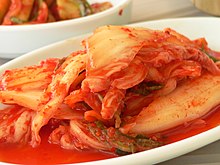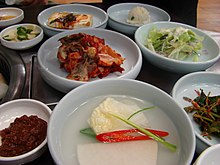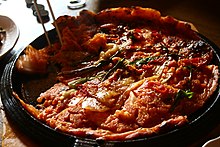Kimchi
From Wikipedia, the free encyclopedia
| Kimchi | |
|---|---|
 | |
| Korean name | |
| Hangul | 김치 |
| Revised Romanization | gimchi |
| McCune–Reischauer | kimch'i |
Kimchi (Korean: 김치;
[edit] History
The earliest references to pickled vegetables in East Asia is found in the Xin Nan Shan 信南山 poem of the Shi Jing (詩經), which uses the character 菹 (Korean "jeo", Mandarin Chinese "zu"). The term ji was used until the pre-modern terms chimchae (hanja: 沈菜, lit. soaked vegetables), dimchae, and timchae were adopted in the period of the Three Kingdoms of Korea.[5] The word then was modified into jimchi, and is currently kimchi.Early kimchi was made of cabbage and beef stock only. Red chili, a New World vegetable not found in Korea before European contact with the Americas, was introduced to Korea from Japan after the Japanese invasions (1592–1598) and became a staple ingredient in kimchi.[6] Red chili pepper flakes are now used as the main ingredient for spice and source of heat for many varieties of kimchi. In the twelfth century other spices, creating flavors such as sweet and sour, and colors, such as white and orange, were added.[7]
[edit] Main ingredients
Kimchi varieties are determined by the main vegetable ingredients and the mix of seasonings used to flavor the kimchi.The Kimchi Field Museum in Seoul has documented 187 historic and current varieties of kimchi. Ingredients can be replaced or added depending on the type of kimchi being made. The most common seasonings include brine, scallions, spices, ginger, chopped radish, garlic, saeujeot (hangul: 새우젓, shrimp sauce), and aekjeot (hangul: 액젓, fish sauce).
[edit] Varieties
Kimchi from the northern parts of Korea tend to have less salt, less red chilli and usually do not have brined seafood for seasoning. Northern kimchi often has a watery consistency. Kimchi made in the southern parts of Korea, such as Jeolla-do and Gyeongsang-do, uses salt, chili peppers and myeolchijeot (hangul: 멸치젓, brined anchovy allowed to ferment) or saeujeot (hangul: 새우젓, brined shrimp allowed to ferment), myeolchiaekjeot (Hangul: 멸치액젓, "kkanariaekjeot" 까나리액젓, liquid anchovy jeot, similar to fish sauce used in Southeast Asia, but thicker).
Saeujeot (hangul: 새우젓) or myeolchijeot is not added to the kimchi spice-seasoning mixture, but is simmered first to reduce odors, eliminate tannic flavor and fats, and then is mixed with a thickener made of rice or wheat starch (Hangul: 풀). This technique has been falling into disuse for the past forty years.
White kimchi (baek kimchi) is baechu (napa cabbage) seasoned without chili pepper and is neither red in color nor spicy. White radish kimchi (dongchimi) is another example of a kimchi that is not spicy. The watery white kimchi varieties are sometimes used as an ingredient in a number of dishes such as cold noodles in dongchimi brine (dongchimi guksu).
[edit] Regions
This regional classification dates back to 1960s and contains plenty of historical facts, but the current kimchi-making trends in Korea are generally different from those mentioned below.[8]- Hamgyeong-do (Upper Northeast): Due to its proximity to the ocean, people in this particular region use fresh fish and oysters to season their kimchi.
- Hwanghae-do (Midwest): The taste of kimchi in Hwanghae-do is not bland but not extremely spicy. Most kimchi from this region has less color since red chili flakes are not used. The typical kimchi for Hwanghae-do is called pumpkin kimchi (bundi).
- Gyeonggi-do (Lower Midwest of Hwanghae-do)
- Chungcheong-do (Between Gyeonggi-do and Jeolla-do): Instead of using fermented fish, people in the region rely on salt and fermentation to make savory kimchi. Chungcheong-do has the most varieties of kimchi.
- Gangwon-do (South Korea)/Kangwon-do (North Korea) (Mideast): In Gangwon-do, kimchi is stored for longer periods. Unlike other coastal regions in Korea, kimchi in this area does not contain much salted fish.
- Jeolla-do (Lower Southwest): Salted yellow corvina and salted butterfish are used in this region to create different seasonings for kimchi.
- Gyeongsang-do (Lower Southeast): This region's cuisine is saltier and spicier. The most common seasoning components include haszing duu and myeolchijeot (멸치젓) which produce a briny and savory flavor.
- Foreign countries: In some places of the world people sometimes make kimchi with western cabbage and many other alternative ingredients such as broccoli.[9][10]
[edit] Seasons
Different types of kimchi were traditionally made at different times of the year, based on when various vegetables were in season and also to take advantage of hot and cold seasons before the era of refrigeration. Although the advent of modern refrigeration — including kimchi refrigerators specifically designed with precise controls to keep different varieties of kimchi at optimal temperatures at various stages of fermentation — has made this seasonality unnecessary, Koreans continue to consume kimchi according to traditional seasonal preferences.[11][edit] Spring
After a long period of consuming gimjang kimchi (hangul: 김장김치) during the winter, fresh potherbs and vegetables were used to make kimchi. These kinds of kimchi were not fermented or even stored for long periods of time but were consumed fresh.[edit] Summer
Summer radishes and cucumbers are summer vegetables made into kimchi, yeolmu kimchi (hangul: 열무김치) which is eaten in several bites. Brined fish or shellfish can be added, and freshly ground dried chili peppers are often used.[edit] Autumn
Baechu kimchi is prepared by inserting blended stuffing materials, called sok (literally inside), between layers of salted leaves of uncut, whole Napa cabbage. The ingredients of sok (hangul: 속) can vary, depending on the different regions and weather conditions. Generally, baechu kimchi used to have a strong salty flavor until the late 1960s when a large amount of myeolchijeot or saeujeot had been used.[edit] Winter
Traditionally, the greatest varieties of kimchi were available during the winter. In preparation for the long winter months, many types of kimjang kimchi (hangul: 김장 김치) were prepared in early winter and stored in the ground in large kimchi pots. Today, modern kimchi refrigerators offering precise temperature controls are used to store kimjang kimchi. November and December are traditionally when people begin to make kimchi; women often gather together in each others' homes to help with winter kimchi preparations. "Baechu kimchi" is made with salted baechu filled with thin strips of radish, parsley, pine nuts, pears, chestnuts, shredded red pepper, manna lichen (석이버섯), garlic, and ginger.[edit] Nutrition and health
Kimchi is made of various vegetables and contains a high concentration of dietary fiber,[12][13] while being low in calories. One serving also provides over 50% of the daily recommended amount of vitamin C and carotene. Most types of kimchi contain onions, garlic, and chilli peppers, all of which are salutary. The vegetables being made into kimchi also contribute to the overall nutritional value. Kimchi is rich in vitamin A, thiamine (B1), riboflavin (B2), calcium, and iron,[14][15] and contains a number of lactic acid bacteria, among those the typical species Lactobacillus kimchii.[16][17][18] Health magazine named kimchi in its list of top five "World's Healthiest Foods" for being rich in vitamins, aiding digestion, and even possibly reducing cancer growth.[19]However, a 2005 study in South Korea found that when eaten in large quantities, kimchi increases the risk of gastric cancer, particularly among people with certain genetic traits.[20]
One study conducted by Seoul National University claimed that chickens infected with the H5N1 virus, also called avian flu, recovered after eating food containing the same bacteria found in kimchi. During the 2003 SARS outbreak in Asia, many people even believed that kimchi could protect against infection, although there was no scientific evidence to support this belief.[21][22] However, in May 2009, the Korea Food Research Institute, Korea’s state food research organization, said they had conducted a larger study on 200 chickens, which supported the theory that it boosts chickens' immunity to the virus.[23]
| Nutrients | per 100 g | Nutrients | per 100 g |
|---|---|---|---|
| Food energy | 32 kcal | Moisture | 88.4 g |
| Crude protein | 2.0 g | Crude Lipid | 0.6 g |
| Total sugar | 1.3 g | Crude fiber | 1.2 g |
| Crude ash | 0.5 g | Calcium | 45 mg |
| Phosphorus | 28 mg | Vitamin A | 492 IU |
| Vitamin B1 | 0.03 mg | Vitamin B2 | 0.06 mg |
| Niacin | 2.1 mg | Vitamin C | 21 mg |
[edit] 1996 Japanese kimchi dispute
In 1996, Korea protested Japanese commercial production of "kimchi" arguing that the Japanese-produced product (kimuchi) was different from kimchi (in particular, that it was not fermented). Korea lobbied for an international standard from the Codex Alimentarius, an organization associated with the World Health Organization that defines voluntary standards for food preparation for international trade purposes.[22][25] In 2001 the Codex Alimentarius published a voluntary standard defining kimchi as "a fermented food that uses salted napa cabbages as its main ingredient mixed with seasonings, and goes through a lactic acid production process at a low temperature", but which did not specify a minimum amount of fermentation nor forbid the use of additives.[26][third-party source needed][edit] 2010 kimchi ingredient price crisis
Due to heavy rainfall shortening the harvesting time for cabbage and other main ingredients for kimchi in 2010, a major spike occurred in the price of kimchi ingredients and kimchi itself. Korean newspapers have labeled this a national tragedy.[27] In response to the Kimchi price crisis, the South Korean government announced the temporary reduction of tariffs on imported cabbage to coincide with the Kimjang season.[28][edit] Gallery
[edit] See also
- Foods containing tyramine
- Jangajji
- Jeotgal
- List of English words of Korean origin
- Pao cai
- Sauerkraut
- Torshi
[edit] References
- ^ [1] Encyclopædia Britannica article on "kimchi"
- ^ Kim, M.; Chun, J. (2005). "Bacterial Community Structure in Kimchi, a Korean Fermented Vegetable Food, as Revealed by 16S rRNA Gene Analysis". International Journal of Food Microbiology. 103(1), 91–96. See Abstract.
- ^ Chin, Mei. "The Art of Kimchi". Saveur. http://www.saveur.com/article/Kitchen/The-Art-of-Kimchi. Retrieved 9 August 2010.
- ^ "A World of Kimchi". Saveur.
- ^ (Korean) 김치의 이름(명칭) from Hankyoreh21
- ^ Yoon, Sook-ja. Good Morning Kimchi! Hollym International Corporation, 2005. Pg. 11
- ^ Kimchi Museum Official Website
- ^ a b "Kimchi." Yahoo Korean Encyclopedia
- ^ "North Texas Traditional Living". Making Kimchi. http://www.traditionaltx.us/Heidi%27s%20kimchi%20recipe.pdf. Retrieved 14 February 2011.
- ^ "TreeLight". Ultimate Kimchi. http://www.treelight.com/health/nutrition/UltimateKimchi.html. Retrieved 14 February 2011.
- ^ "High-tech kimchi refrigerators keep Korea's favorite food crisp". Hong Kong Trade Development Council. 14 March 2002. http://www.tdctrade.com/imn/02031402/food19.htm. Retrieved 14 February 2008.
- ^ Kimchi Nutritional Value
- ^ Kimchi by Nancy Berkoff, RD, EdD, CCE
- ^ "Food in Korea". Asianinfo.com. http://www.asianinfo.org/asianinfo/korea/food.htm#KIM%20CHI. Retrieved 30 January 2007.
- ^ "Kimchi". Tour2korea.com. http://english.visitkorea.or.kr/enu/OO/OO_EN_13_1_2.jsp?cid=347478. Retrieved 30 January 2007.
- ^ http://ijs.sgmjournals.org/cgi/reprint/50/5/1789.pdf
- ^ Jung-Sook Leea, Gun-Young Heoa, Jun Won Leea, Yun-Jung Oha, Jeong A Parka, Yong-Ha Parka, Yu-Ryang Pyunb and Jong Seog Ahn (15 July 2005). "Analysis of Kimchi Microflora Using Denaturing Gradient Gel Electrophoresis". International Journal of Food Microbiology. Volume 102, Issue 2. pp. 143–150.
- ^ Myungjin Kim; Jongsik Chun (15 August 2005). . "Bacterial Community Structure in Kimchi, a Korean Fermented Vegetable Food, as Revealed by 16S rRNA Gene Analysis. International Journal of Food Microbiology. Volume 103, Issue 1. pp. 91–96
- ^ Raymond, Joan. "World's Healthiest Foods: Kimchi (Korea)". Health.
- ^ "Kimchi and soybean pastes are risk factors of gastric cancer". World Journal of Gastroenterology 11 (21): 3175–3181. 2005. http://www.wjgnet.com/1007-9327/11/3175.pdf. Retrieved 31 January 2012.
- ^ "Korean Dish 'May Cure Bird Flu'". BBC News. 14 March 2005. http://news.bbc.co.uk/2/hi/asia-pacific/4347443.stm. Retrieved 4 April 2010.
- ^ a b Magnier, Mark (17 June 2003). "In an Age of SARS, Koreans Tout Kimchi Cure". Los Angeles Times. http://articles.latimes.com/2003/jun/17/entertainment/et-magnier17. Retrieved 7 May 2010.
- ^ "Kbs Global". English.kbs.co.kr. http://english.kbs.co.kr/News/News/News_view.html?id=Dm&No=63596. Retrieved 9 August 2010.
- ^ from Korea Food Research Institute
- ^ Sims, Calvin (February 2000) "Cabbage Is Cabbage? Not to Kimchi Lovers; Koreans Take Issue with a Rendition of Their National Dish Made in Japan". The New York Times.
- ^ CODEX STANDARD FOR KIMCHI The Codex Alimentarius Commission
- ^ McDonald, Mark (14 October 2010). "Rising Cost of Kimchi Alarms Koreans". The New York Times. http://www.nytimes.com/2010/10/15/world/asia/15kimchi.html?_r=2&src=me&ref=general. Retrieved 16 October 2010.
- ^ Staff (7 October 2010). October 2010 "South Korea's Kimchi Crisis". The Economist. http://www.economist.com/node/17204655?story_id=17204655 October 2010.
[edit] Further reading
- Park, Kun-Young; Cheigh, Hong-Sik (2003). Handbook of Vegetable Preservation and Processing. CRC Press. pp. 189–222. ISBN 0-8247-4301-6. http://books.google.com/?id=dVpQVJ46C5gC&pg=PA192&dq=kimchi. Retrieved 18 May 2008.
- Gannon, Martin J. (2004). Understanding Global Cultures. Sage Publications. pp. 123–130. ISBN 0-7619-2980-0. http://books.google.com/?id=4X0KY9cVm7MC&pg=PA123&dq=kimchi. Retrieved 18 May 2008.
[edit] External links
| Wikibooks Cookbook has a recipe/module on |
| Wikimedia Commons has media related to: Kimchi |
- The A to Z's of Kimchi - The Official Korea Tourism Guide Site
- Korean traditional kimchi site sponsored by the Korean Agro-Fisheries Trade Corp.
- Kimchi > History at the Korea Tourism Organization official site
- Korea Food Research Institute
| |||||











댓글 없음:
댓글 쓰기